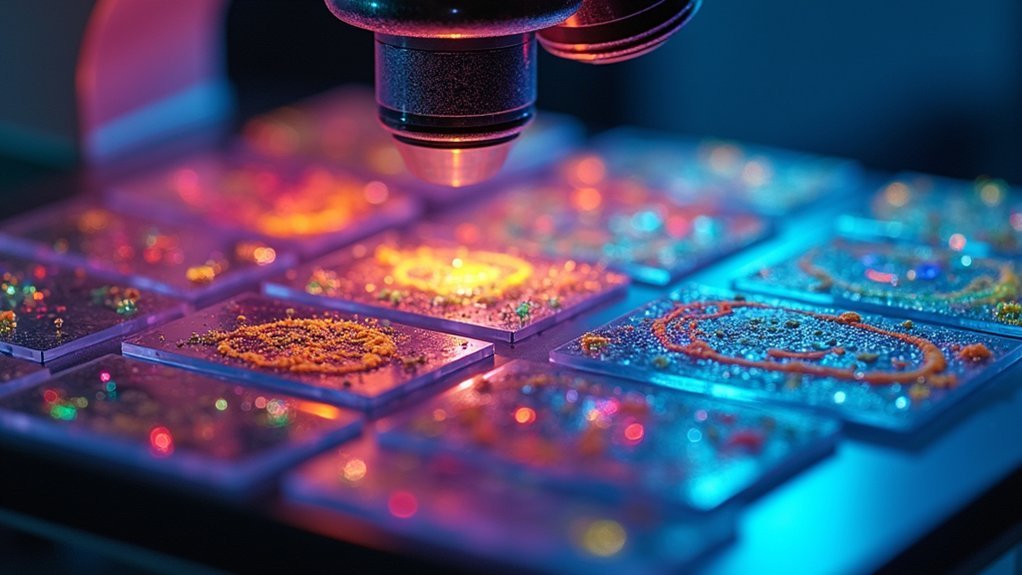Infinity objectives dramatically improve your lab images through superior chromatic aberration correction, enhanced light transmission, seamless integration of optical components, consistent magnification across techniques, improved working distance, reduced spherical aberrations, and optimized field flatness. You’ll capture sharper details with edge-to-edge clarity and experience minimal light loss while easily adding filters or specialized optics. These advantages translate to clearer images and more reliable data across brightfield, fluorescence, and DIC applications. Discover how these sophisticated objectives can transform your microscopy results.
Superior Chromatic Aberration Correction for Sharper Images

The battle against color fringing finds its champion in infinity corrected objectives. These sophisticated microscope systems utilize a carefully engineered objective and tube lens combination to effectively minimize chromatic aberration across your entire field of view.
Infinity corrected objectives: microscopy’s secret weapon in the ongoing war against chromatic aberration.
With focal lengths typically ranging from 164.5-250mm, infinity objectives deliver superior chromatic aberration correction compared to finite systems.
You’ll appreciate the ability to add optical components like filters and beam splitters in the infinity space without introducing new aberrations—maintaining exceptional image quality throughout.
Residual longitudinal chromatic aberration is further reduced by the objective’s color correction grade, resulting in remarkably sharp images essential for precise lab work.
Remember to avoid mixing objectives from different manufacturers to guarantee consistent optical performance and prevent incompatible focal lengths from compromising your results.
Enhanced Light Transmission Through the Infinity Space
Maximizing light efficiency represents another significant advantage of infinity objectives beyond their impressive chromatic aberration correction. When you use these objectives, they produce parallel light rays that travel through the infinity space without degradation, allowing you to add optical components while maintaining image quality.
Infinity-corrected systems prevent spherical aberration, ensuring efficient light transmission to the intermediate image plane. With focal lengths between 164.5mm and 250mm, various manufacturers’ objectives remain compatible, enhancing your imaging capabilities.
The tube lenses in these systems capture and focus parallel rays, maximizing light transmission for superior results. This optimized light path particularly benefits advanced imaging techniques like fluorescence microscopy, where every photon matters.
You’ll achieve stronger signals and more consistent outcomes as the clear path minimizes light losses throughout the system.
Seamless Integration of Optical Components and Filters

Unlike traditional objectives that struggle with additional components, infinity objectives excel at accommodating optical devices in the infinity space without compromising image quality. When you add beam splitters or emission filters, you won’t need to adjust focus or worry about degraded images, thanks to the parallel light path these systems maintain.
The standardized tube length of infinity objectives guarantees compatibility across manufacturers, allowing you to mix and match optical components without introducing spherical aberration or altering the effective tube length.
This versatility transforms your microscopy techniques, making advanced imaging methods like fluorescence and DIC more accessible. You’ll appreciate how infinity objectives keep your intermediate image stable regardless of added components, preventing focal point shifts that could disrupt your observations.
The result? Seamless integration that enhances your lab’s imaging capabilities.
Consistent Magnification Across Multiple Imaging Techniques
Consistency in magnification represents one of infinity objectives’ most valuable benefits for laboratory imaging applications. When you use infinity corrected systems, you’ll achieve reliable results across brightfield, fluorescence, and DIC techniques without recalibration. The parallel light rays traveling between the objective and tube lens maintain your specimen’s magnification regardless of additional optical components inserted into the light path.
| Technique | Benefit | High NA Compatibility |
|---|---|---|
| Brightfield | No focus shift when switching objectives | Excellent |
| Fluorescence | Consistent field illumination | Superior |
| DIC | Preserved contrast relationships | Exceptional |
Your magnification calculations remain straightforward—simply multiply objective and eyepiece values. This consistency eliminates the compatibility issues common with proprietary objective designs from different manufacturers, ensuring you won’t encounter unexpected magnification discrepancies when integrating components into your imaging workflow.
Improved Working Distance for Better Sample Access

When conducting delicate laboratory procedures, infinity objectives provide considerably longer working distances than their finite counterparts, revolutionizing your ability to access and manipulate samples.
This improved working distance allows you to work with thick specimens without risking collision between your objective and sample, enhancing operational safety during your experiments.
You’ll appreciate how infinity-corrected systems maintain excellent image quality despite this extended distance, preventing spherical aberrations common in traditional finite setups.
The extra space accommodates additional accessories like filters or beamsplitters without compromising performance.
This versatility transforms your experimental setups, enabling you to work with diverse sample types and conditions.
Whether you’re examining living specimens or integrating specialized equipment, the longer working distance of infinity objectives guarantees better sample access without sacrificing imaging precision.
Reduced Spherical Aberrations for Higher Resolution Details
You’ll notice considerably crisper peripheral structures when using infinity objectives due to their inherent reduction of spherical aberrations.
These advanced objectives create a flatter imaging field, preserving detail clarity even at the edges of your specimens.
The reduced distortion allows you to capture fine structural elements with exceptional precision, particularly beneficial for complex tissue samples or intricate cellular components.
Crisp Peripheral Structures
Microscopy technicians value infinity objectives primarily because they dramatically reduce spherical aberrations at the edges of the viewing field. When you’re examining complex samples, these objectives guarantee your peripheral structures remain as crisp and detailed as the center of your image.
The magic happens as parallel light rays exit the objective, creating consistent focus across your entire field of view. You’ll notice enhanced resolution and clarity, especially at the edges where conventional objectives often struggle.
By incorporating high numerical aperture infinity objectives, you’re maximizing light gathering capability for even the finest details.
What’s more, you can add auxiliary optical components within the infinity space without compromising image quality. This eliminates the need for focus correction, keeping your peripheral structures stable and well-defined throughout your microscopy sessions.
Flatter Imaging Field
While traditional objectives often create curved focal planes, infinity objectives deliver a remarkably flatter imaging field across your entire viewing area. This improvement stems from their unique design that emits parallel light rays, greatly reducing spherical aberrations that typically distort peripheral details.
You’ll notice dramatically improved resolution with infinity objectives, revealing fine structures that were previously obscured. The consistent optical quality guarantees every region of your specimen remains sharp and focused—no more compromising on detail clarity regardless of where it falls in your field of view.
When you’re conducting advanced techniques like DIC or fluorescence microscopy, you’ll appreciate the enhanced contrast and image clarity these objectives provide.
Even when you add optical components in the infinity space, your resolution remains preserved, giving you versatile imaging capabilities without sacrificing quality.
Optimized Field Flatness for Edge-to-Edge Clarity

When examining laboratory specimens, field flatness becomes a critical factor in producing reliable, high-quality images. Infinity-corrected objectives, particularly plan-apochromats, deliver optimized field flatness that guarantees your image clarity remains consistent from center to edges. You’ll notice uniform sharpness across your entire specimen, eliminating the frustration of focusing on either the center or periphery.
| Objective Type | Edge Clarity | Post-Processing Needed |
|---|---|---|
| Standard | Poor | Extensive |
| Semi-Plan | Moderate | Significant |
| Plan | Good | Minimal |
| Plan-Fluor | Very Good | Minimal |
| Plan-Apochromat | Excellent | Nearly None |
In fluorescence microscopy applications, this edge-to-edge clarity is invaluable as it provides consistent image quality and uniform illumination. The tube lenses in infinity optics effectively correct optical aberrations, streamlining your workflow by reducing post-processing adjustments in laboratory settings.
Frequently Asked Questions
What Are the Advantages of Infinity Corrected Objectives?
Infinity corrected objectives let you insert optical components without compromising image quality, maintain parfocality across magnifications, reduce aberrations for sharper images, offer wider tube length compatibility, and minimize chromatic aberration for better color fidelity.
What Are Infinity Objectives on a Microscope?
Infinity objectives are microscope lenses that produce parallel light rays rather than focused ones. You’ll find they allow you to add optical components between the objective and eyepiece without compromising your image quality.
What Are the 4 Objectives of a Microscope?
Your microscope has four main objectives: low power (4X), medium power (10X), high power (40X), and oil immersion (100X). Each offers different magnification levels to observe specimens with increasing detail and clarity.
What Is the Purpose of Having Multiple Objective Lenses?
Multiple objective lenses allow you to switch between magnifications, giving you different levels of detail. You’ll achieve better resolution for specific applications, maintain parfocality, and can utilize various microscopy techniques for thorough specimen examination.
In Summary
By adopting infinity objectives in your lab, you’ll revolutionize your imaging capabilities. You’re getting sharper, more color-accurate images with better light transmission and consistent magnification across techniques. You’ll appreciate the improved working distance, reduced aberrations, and edge-to-edge clarity these objectives provide. Whether you’re conducting research or routine analysis, infinity objectives aren’t just an upgrade—they’re essential for achieving the highest quality microscopy results.





Leave a Reply